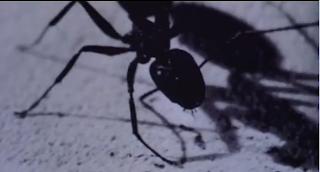Point 1
Camera: There is a close-up of Peter from a profile angle which doesn't show his eyes. This continues the idea of his disconnection from reality. Although it is a close-up, the angle and lack of eyes in the shot make it hard for the audience to bond with Peter.
There is a close-up of hair and blood in the sink. The blood stands out from the white of the sink and is a graphic, visual shot which makes the audience realise how hard it is for Peter to do everyday things. It also shows a realistic, slightly gruesome representation of schizophrenia.

Editing: The cutaway to the shot of the blood and hair in the sink shows the audience how the process has been ongoing. It gives a slightly repulsive, graphic edge to the scene.
Sound: There is no non-diegetic sound in the scene and so the sound of Peter shaving and the tap water is emphasised. This makes it more tense and uses the effect of replicating the amount of concentration and effort it takes Peter to do daily activities.
Mise en Scene: The shot of Peter is tightly framed which gives the effect of Peter not being able to escape the difficulty of his life and illness. This is effectively used along with the stark density of the shot, which gives the impression of it being a simple task, yet so tense and complicated for Peter. The red is starkly contrasted against the white and this makes the image more graphic and startling.
Point 2
Camera: There is a medium shot of Peter from a low angle as he shaves his chest. The low angle makes him look big which is contrasted to his inability to do everyday actions and this causes him to seem even more vulnerable. By allowing the audience to see more of Peter, we can see the amount of damage he has caused to himself by doing the simple task of shaving.
 Editing: There is another cutaway to the drain in the shower, which helps to emphasise again the amount of blood and cuts he has inflicted upon himself. The dirt in the shower is also highlighted, which goes to show that he does not usually take very good care of himself.
Editing: There is another cutaway to the drain in the shower, which helps to emphasise again the amount of blood and cuts he has inflicted upon himself. The dirt in the shower is also highlighted, which goes to show that he does not usually take very good care of himself.Sound: The non-diegetic sound of the running tap is all that can be heard which puts the audience in the POV of Peter without any distractions.
Mise en scene: The stark density of the shot gives the impression of it being a simple task, yet so tense and complicated for Peter, as well as adding focus onto his actions. The green in the shot acts as a contrasting foil to the blood, highlighting its significance.
Point 3
Camera: There is a close-up of Peter in bed which only shows his eyes, which shows that the scene is being shown inside his mind, matching with the soundtrack. He is shown in the left, bottom corner of the shot which makes him seem small and vulnerable.
Editing: There is eye-line match to a shot of the wall, which is in the POV of Peter, emphasising how he is staring at it and that his mental illness occupies him so much that he doesn't have the ability to do much else.
Sound: The low sound of whispering can be heard which is fast paced and the audience is unable to decipher what it is saying, making it disorientating and slightly on edge. This links in with the POV shot, as well as the shot of Peter's eyes as it gives the impression that we are inside Peter's mind, hearing what he is hearing.
Mise en scene: The stark density of the shots, especially in the one of the wall, as well as the use of the colour white (connoting vacancy) put across how empty and depressing Peter's life is.
Point 4
Camera: There is a long shot, from a high angle of Peter curled up on the floor of a bare room. The high angle as well as the long shot makes him look extremely small and vulnerable. There is also another shot of the telephone wires being tracked, which is repetitively used throughout the film to connote Peter's unstable state of mind.
 Editing: A flashback of Peter's past is used to show how he is haunted by past memories in a mental asylum. A cutaway of the telephone wires is used again to show how he can't escape the delirium.
Editing: A flashback of Peter's past is used to show how he is haunted by past memories in a mental asylum. A cutaway of the telephone wires is used again to show how he can't escape the delirium.Sound: The non-diegetic sound of the whispered is layered by the sound of bass voices sounding like ghosts, connoting how he is haunted. The electrical, static sounds come back along with the telephone wires, which has a disorientating effect.
Mise en Scene: The flashback of Peter used stark density and very loose framing in order to make him seem vulnerable and threatened, emphasised by his position. The grey colour of his shirt blends in with the white/grey background and yet again connotes the vacancy of his life, showing that he is socially isolated. The diagonal composition in the shot of the telephone wires is used again to show how Peter is on edge and something isn't quite right/
















































